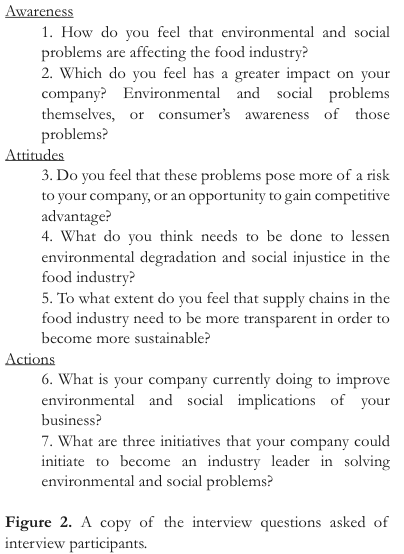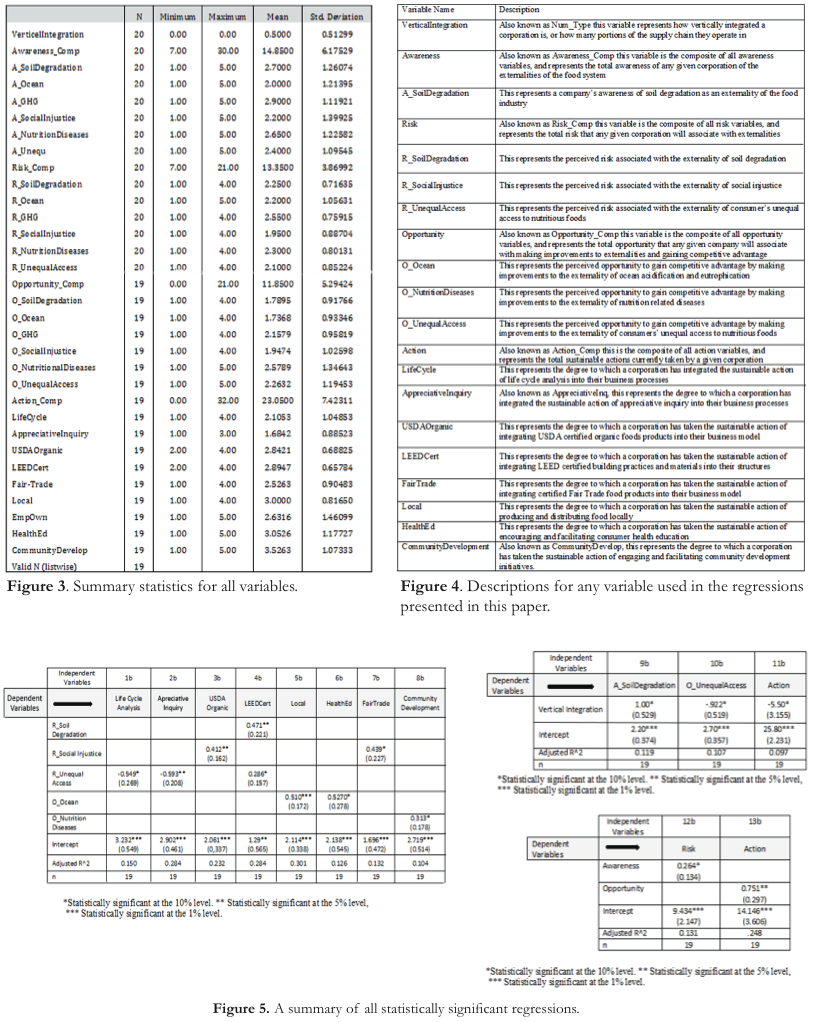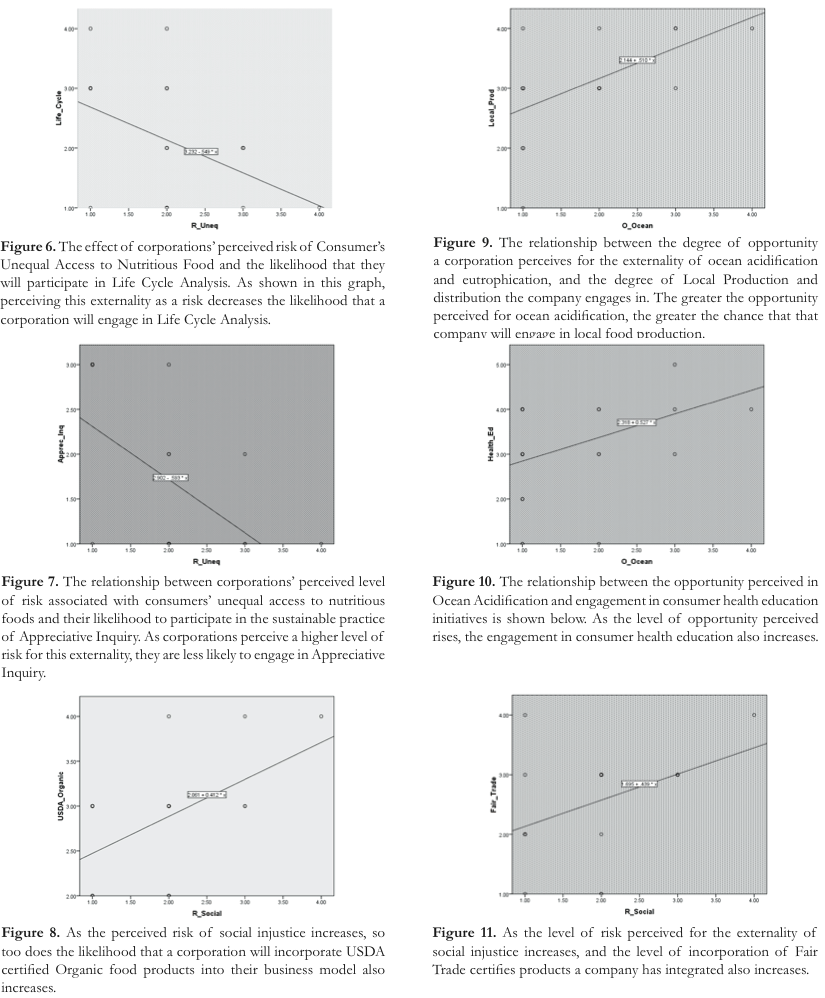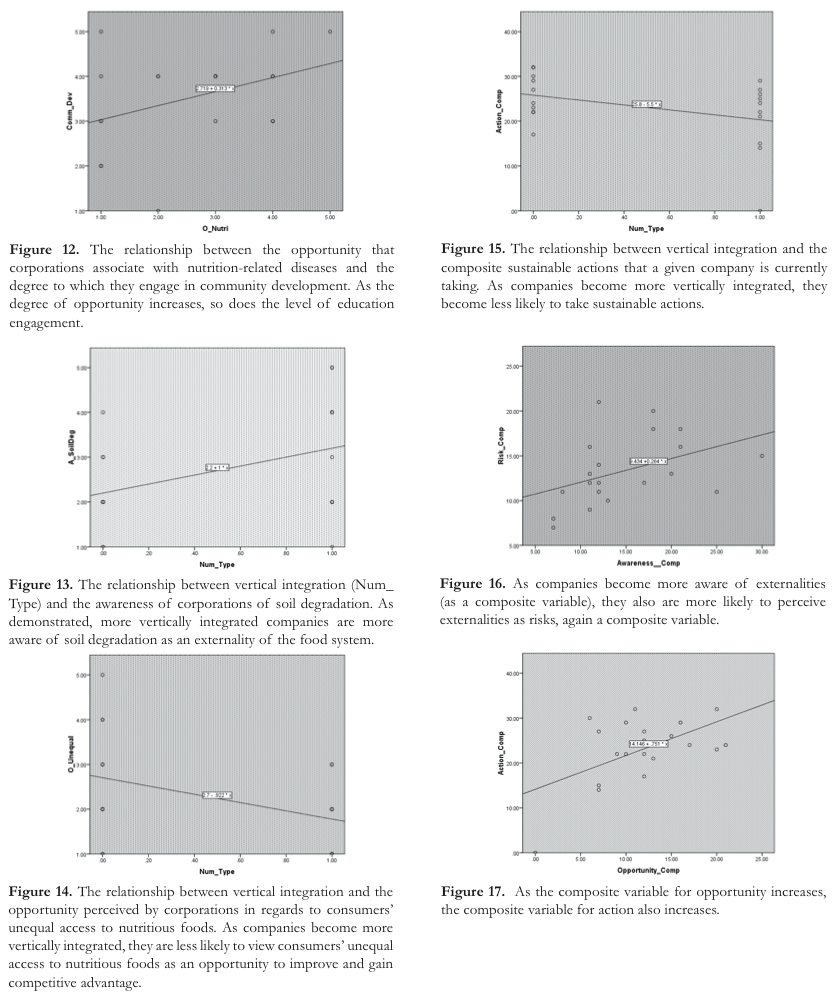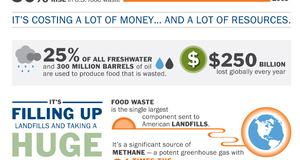From Discussions VOL. 10 NO. 1Toward A More Sustainable Food Supply Network: An Economic Analysis of Sustainability in the United States Food IndustryLIMITATIONSThe various limitations to these results revolve primarily around the general low response rate received from the sample. This low response rate could have originated from a perceived bias that respondents sensed in the questions. Of the 40 individuals that started the survey, 23 industry. As leaders of some of the largest corporations within the industry, it is possible that corporations thought that by stating they were aware of the externalities, they would implicate themselves as accepting blame. A possible way to gain more responses and remove the perceived bias could be by rephrasing the questions from “To what extent are you aware of soil degradation as a consequence of the industrial food production process?” to “To what extent do you feel that soil degradation is a consequence of the industrial food production process?” This data set could also be limited by omitted variables bias, as many variables go into determining whether or not a company takes sustainable action or if they view externalities as risks or opportunities. Similarly, as many of the corporations surveyed were privately held, it was not possible to cross reference these variables with existing data from external sources. CONCLUSIONS AND DISCUSSIONAfter analyzing the results from the above statistical regression of data, a few takeaway conclusions have become the externalities of the food system as risks, they may not take actions on those risks, and thus are less likely to act risks that had a negative impact on the likelihood of taking social injustice, rather than environmental ones. Perhaps there is an industry bias that solving social externalities environmental externalities present an opportunity to the CEO of a major food processing corporation, who would prefer to remain anonymous, he states that: “[Attaining] competitive advantage is pretty hard. Just because you use less water or less energy, that’s great to say in my opinion, but in the end in the grocery store, consumers are looking at price. ...The reality is that most folks are only concerned with their pocket books. ...If I can use less water, if I can use less energy, it is not only good for the environment; it’s good for my business. So the projects that are associated with savings that have environmental opportunities, we will go after more aggressively than opportunities that don’t have dollars associated with them. It is a strategic business decision” (Anonymous, personal communication, March 6, 2013). Similarly, in an interview with Vice President Keith Slater of Ruby Tuesday, a national restaurant chain, Slater explained how social externalities are “more of a risk. While we can take advantage of social programs as part of our food integrity program, it is very hard to leverage to the point of being an advantage, so the risk side ... is much greater.” (personal communication, March 4, 2013). From to drive sustainable action would be to communicate to corporate leaders how improving the social implications of their business, such as social injustice and consumer’s potentially be the missing link between perceptions of risk and opportunity. A second major conclusion is the close relationship between perceptions of social injustice as a risk, and taking the sustainable action of incorporating fair trade products. It is logical that externalities that are so closely linked to companies can clearly see the connection between either they are likely to take that action. Bon Appetite Management Company, also known as BAMCo, a nationwide industrial catering and distributioncompany, has dedicated itself to numerous social and environmental sustainable actions, including their Fair Trade chocolate sourcing. As a Fair Trade advocate, Vice President of BAMCo, Maisie Greenawalt, states that “the way that farm workers lack protection and rights in this country is astounding, and that’s a major social problem” (personal communication March 15). In this risks of social injustice, in that it may encourage Fair Trade procedures throughout the supply chain. Not all companies, however, even perceive that social injustice is an externality of the U.S. food system. For instance, an anonymous CEO stated that: “In the food industry in the U.S., I have a hard time believing that there is any social injustice. Most food in the U.S. is based here, and ... I quite candidly don’t believe there is any social injustice” (Anonymous, personal communication, March 6, 2013). In this case, perhaps driving sustainable action first starts with communicating the various social externalities of the food system to the members of that system, and then communicating how those externalities affect an individual’s corporation. This communication can come from Non- Governmental Organizations (NGOs) or other corporations from within the supply chain. A third major takeaway is the impact that perceiving to improve can have on the production and distribution of local food as well as on consumer health education initiatives. While it is hard to connect why the opportunity education, the connection between local food production Local food production has increased in popularity among consumers partly because of the less frequent use of and eutrophication, among other environmental and health- related concerns. Corporations that consider the decrease in growth products through localized production. However, further research would be required into this connection, as well as the connection between the opportunity of ocean acidification and consumer health education. The fourth major conclusion from these regressions is the impact that vertical integration has on awareness, attitudes, and actions. While vertical integration led to an increase in corporations’ awareness of soil degradation, it was also correlated with a decrease in the level of opportunity that corporations associated with consumer’s unequal access to nutritious foods as well as lower levels of sustainable action. If a corporation is extremely vertically integrated, they have more information about the supply chain as a whole, and supply chain transparency is not an issue for them. This would lead to increased awareness of the problems created by the supply chain as a whole, such as soil degradation in this instance. In an interview with Mike Fernandez, vice president of Cargill, he explained how he did not feel that supply chain transparency was a concern in the industrial supply chain due to the “USDA inspectors, [and] tests where the products are examined as a result of that consolidation that doesn’t take place in a less consolidated environment” (personal communication, March, 14, 2013). Cargill, a food processing and distribution company, is the largest private company in the world and incredibly vertically integrated. Therefore, it is not likely to see supply chain transparency as an issue of the supply chain. As Maisie Greenawalt states: “We’re operating in at least a national and in many cases, a global food system. As we get farther and farther away from our food source, and there are more middle men in the process, we lose transparency, and I think that a fair amount of that has been intentional on the part of our producers. They don’t want you to know who they are. They don’t want you to ask questions” (M. Greenawalt, personal communication, March 15). Maisie goes on to discuss the challenges of transparency when negotiating with large corporations for sustainable products: “We need more transparency in the supply chain [to] allow food purchasers on all levels to make decisions based on their values. When I say all levels, I mean everything from a large purchaser like Bon Appetite, all the way to an individual consumer. We can’t make ethical purchasing decisions all the time, because we don’t have the information either. We need more transparency for everyone” (personal communication, March 15). Differing perspectives are represented in the statistical regression analysis above. The more vertically integrated a company is, the more aware they are of externalities; logically because there are fewer issues of supply chain transparency within the corporation. In terms of public policy, it is transparency, allowing corporations and the transaction channels between each corporation to operate as a vertically integrated corporation without the negative externalities of a consolidated non-competitive market. This problem deserves further research in the field.Continued on Next Page » Suggested Reading from Inquiries Journal
Inquiries Journal provides undergraduate and graduate students around the world a platform for the wide dissemination of academic work over a range of core disciplines. Representing the work of students from hundreds of institutions around the globe, Inquiries Journal's large database of academic articles is completely free. Learn more | Blog | Submit Latest in Economics |

